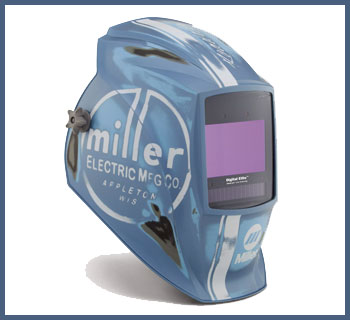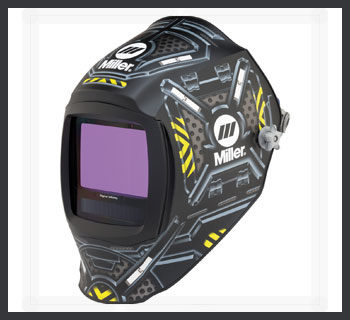There are many other welding helmet alternatives available, but the Miller Digital Elite and the Miller Infinity are two of the more popular versions. Making a decision between the two helmets might be challenging since they both offer advantages and disadvantages.
This article will explore deeply each helmet’s features, benefits, and downsides to help you to choose the best one.
A Brief Comparison Table
| Feature | Digital Elite | Infinity |
| Auto-Darkening Lens | Yes | Yes |
| Adjustable Shades | Yes | Yes |
| Clear Mode | Yes | No |
| Arc Sensors | 4 | 4 |
| Grinding Mode | Yes | Yes |
| Clear Optics Technology | No | Yes |
| Large Viewing Area | No | Yes |
| InfoTrack Lens Technology | No | Yes |
| Weight | 18 oz. | 23 oz. |
Differences Between Miller Digital Elite And Infinity Welding Helmet
The Miller brand is one of the most well-known in the welding helmet market. Two of the most popular models are the Miller Digital Elite and the Miller Infinity.
While both helmets have some similarities, they also have some key differences that are worth considering before making a purchase. Let’s take a closer look at the differences between the Miller Digital Elite and Infinity welding helmets.
- Auto-Darkening Lens

One of the most important features of any welding helmet is the auto-darkening lens.
Both the Miller Digital Elite and Infinity have auto-darkening lenses, but there are some differences between the two.
The Digital Elite has an adjustable shade range of 5-13, which can be helpful for different types of welding tasks.
The Infinity has a somewhat larger range of 5-8 and 8-13, in contrast.
The Infinity also has ClearOptics lens technology, which provides a crystal-clear view of the welding area.
- Arc Sensors
Another important feature to consider is the number of arc sensors. The Digital Elite has four arc sensors, which provide excellent coverage and quick darkening when an arc is detected.
The Infinity also has four arc sensors, but they are positioned in a way that provides a larger viewing area. This can be helpful for welders who need to see more of the welding area.
- Viewing Area
Speaking of viewing area, this is another area where the Digital Elite and Infinity differ. While the Infinity has a bigger viewing area of 13.4 square inches, the Digital Elite has a slightly lesser viewing area of 9.22 square inches.
The larger viewing area of the Infinity can be helpful for welders who need to see more of their work area, but some users may prefer the smaller and more compact design of the Digital Elite.
- Controls
The controls on the Digital Elite and Infinity are also slightly different. The Digital Elite boasts a sizable, user-friendly control panel on the side of the helmet that enables fast and simple configuration adjustments.
The Infinity, on the other hand, has a touch screen control panel on the inside of the helmet. While some users may enjoy the more contemporary touch screen interface, others could find it more challenging to operate than the Digital Elite’s conventional control panel.
- Weight and Comfort
Finally, it’s worth considering the weight and comfort of the helmets. The 18 ounce weight of the Digital Elite makes it rather light and comfortable to wear for prolonged periods of time. On the other side, the Infinity weights 23 ounces, which may be a little more than certain users would want.
However, the Infinity also has a more comfortable headgear system that is designed to distribute the weight more evenly and reduce fatigue.
Miller Digital Elite
The Miller Digital Elite welding helmet is a popular choice for both professional and hobbyist welders. The auto-darkening lens of this helmet, which can be changed to a variety of shades depending on the welding work at hand, is one of its most notable characteristics.
The lens also has a transparent mode that allows users to see through it without having to elevate it.
Another great feature of the Digital Elite is its four arc sensors, which provide excellent coverage and ensure that the lens darkens quickly when an arc is detected. The helmet also has a grinding mode, which allows the user to switch the lens to a lighter shade for grinding and prep work.
Pros:
- Auto-darkening lens with adjustable shades
- Clear mode for improved visibility
- Four arc sensors for quick darkening
- Grinding mode for versatility
Cons:
- Price point may be too high for some users
- Lens can be difficult to replace
- Not the most lightweight helmet on the market
Miller Infinity

The Miller Infinity welding helmet is another popular option that is often compared to the Digital Elite.
One of the most notable features of the Infinity is its clear optics technology, which provides a crystal-clear view of the welding area.
The helmet also has a large viewing area, which provides excellent visibility for welding tasks.
Another standout feature of the Infinity is its InfoTrack lens technology, which allows the user to track arc time and other important information directly from the helmet.
This can be a useful feature for those who need to track their welding time for billing purposes or for quality control.
Pros:
- Clear optics technology for improved visibility
- Large viewing area
- InfoTrack lens technology for tracking welding time
- Lightweight and comfortable to wear
Cons:
- Auto-darkening lens may not be as quick to darken as the Digital Elite
- Some users may find the controls difficult to use
- Price point may be too high for some users
As the above information, you may see. Each helmet has pros and cons. The Digital Elite has a clear mode and is slightly lighter, but the Infinity has clear optics technology and a larger viewing area. Both helmets have an auto-darkening lens and adjustable shades, and both have four arc sensors.
The choice between the Miller Digital Elite and Infinity ultimately boils down to personal taste. If you value a clear mode and a slightly lighter weight, the Digital Elite might be the better choice for you. If you prioritize clear optics technology and a larger viewing area, the Infinity might be the way to go.
Also Read: Differences Between Phenix TL-2 And Cairns N5A Helmets.
Conclusion
When it comes to welding helmets, the Miller Digital Elite and Infinity are two of the leading choices available. Each helmet has its own distinct advantages and disadvantages, meaning that selecting between them really boils down to personal preference.
Take a moment to consider which features you value most highly as well as how you plan on using your new helmet before making any decisions.
No matter what kind of welding helmet you select, safety is always paramount. Make sure your chosen model fits properly and will provide adequate coverage while also following all applicable safety regulations when working with hot metals or other hazardous materials associated with many welding projects.
So in summary, when deciding between the Miller Digital Elite and Infinity helmets both come packed with useful features such as an auto-darkening lens and adjustable shades alongside four arc sensors for added protection from sparks or spatter.
The former offers clear mode viewing capabilities plus a lighter weight option whilst the latter boasts clearer optics technology together with increased visibility due to its bigger viewing area – ultimately though it’s up to each individual user depending on their needs which one they prefer best!
Remember that protecting yourself should be a top priority – so choose wisely!



